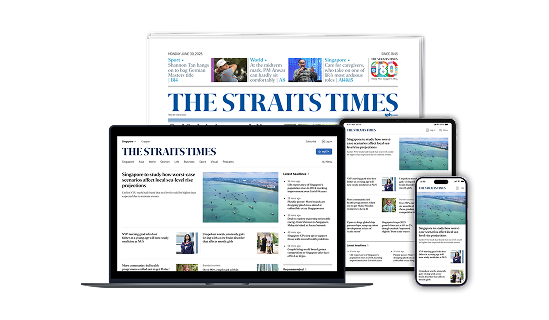Branson's flight fuels hopes of space tourism
Enthusiasts want travel to final frontier to be more mainstream, but financial barrier remains
Sign up now: Get ST's newsletters delivered to your inbox
Follow topic:
SPACEPORT AMERICA (New Mexico) • Soaring more than 80km into the hot, glaringly bright skies above New Mexico, Mr Richard Branson at last fulfilled a dream that took decades to realise: becoming an astronaut.
On Sunday morning, a small rocket plane operated by Virgin Galactic, which Mr Branson founded in 2004, carried him and five others to the edge of space and back.
More than an hour later, he took to the stage to celebrate, saying: "The whole thing was magical."
Later, during a news conference, Mr Branson was still giddy, saying: "I don't know what's going to come out of my mouth because I feel I'm still in space."
The flight reinforces space enthusiasts' hopes that routine travel to the final frontier may soon be available to private citizens, not just professional astronauts. Another billionaire with his own rocket company - Amazon founder Jeff Bezos - has plans to make a similar jaunt next week.
Billionaire entrepreneurs are risking injury or death to fulfil their childhood aspirations and make human spaceflight unexceptional.
"They're putting their money where their mouth is, and they're putting their body where their money is," said Mr Eric Anderson, chairman of Space Adventures, a company that charters launches to orbit. "That's impressive, frankly."
At 8.40am, a carrier aircraft with the rocket plane VSS Unity tucked underneath rose off the runway and headed to an altitude of about 13.7km. There, Unity was released, and a few moments later, its rocket motor ignited, accelerating the space plane on an upward arc.
Although Unity had made three previous trips to space, this was its first resembling the sort of commercial flight Virgin has promised to offer the public.
The launch, with two pilots and four more crew members, including Mr Branson in tow, resembled a party for Virgin and the nascent space tourism business.
Guests at the event included Mr Elon Musk, founder of SpaceX; Ms Michelle Lujan Grisham, Governor of New Mexico; and about 60 customers who have paid for future Virgin flights. Late Show host Stephen Colbert introduced segments of the webcast. After the landing, R&B singer Khalid performed a new song.
When the fuel was spent, Unity continued to coast upwards to an altitude of 86km. The four people in the back unbuckled and experienced four minutes of floating before returning to their seats.
Mr Branson was accompanied in the cabin by Ms Beth Moses, the company's chief astronaut instructor; Mr Colin Bennett, lead operations engineer; and Ms Sirisha Bandla, vice-president of government affairs and research.
Mr Bennett said he was busy with tasks during the first part of the flight. Then he heard Ms Moses shouting: "Don't forget to look out the window." He did. "It's very Zen," Mr Bennett said of his view of Earth. "What jumped out at me were the colours and how far away it looked. It felt like we were so far up there, and I was just mesmerised."
Mr Michael Moses, president of Virgin Galactic, said the flight appeared to go flawlessly. "The ship looks pristine, no issues whatsoever," he said.
For over a decade, Mr Branson, the 70-year-old British billionaire who runs a galaxy of Virgin companies, has said he believes commercial space flights will soon begin.
So did the 600 or so customers of Virgin Galactic who paid at least US$200,000 (S$270,400) for their tickets to space and are still waiting. So did the taxpayers of New Mexico who paid US$220 million to build Spaceport America, a futuristic vision in the middle of the desert, to attract Mr Branson's company.
After years of unmet promises, Virgin Galactic may begin flying the first paying passengers next year after two more test flights. But with tickets costing hundreds of thousands of dollars, this experience will, for now, remain out of reach for most people.
NYTIMES

